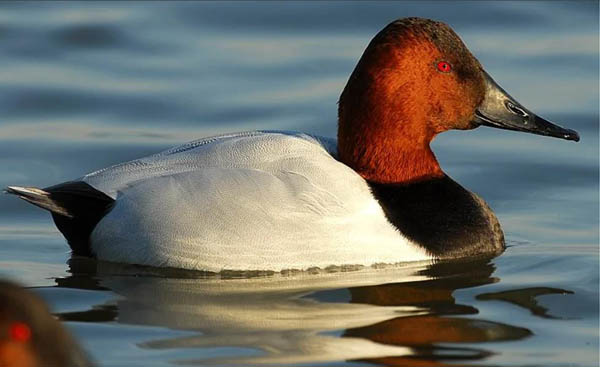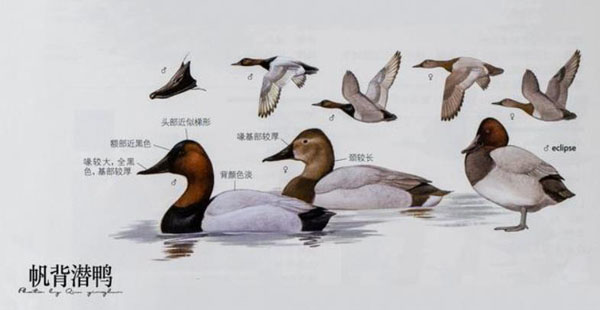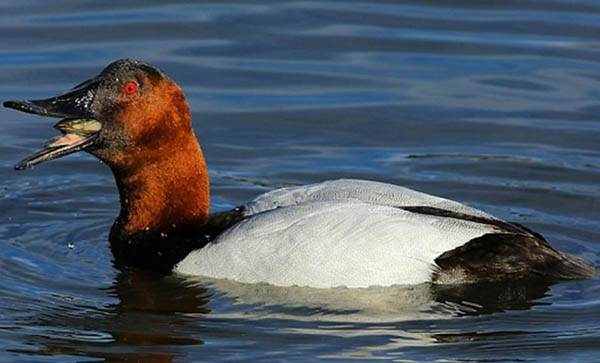Aythya valisineria
IUCN
LCBasic Information
Scientific classification
- name:Aythya valisineria
- Scientific Name:American Rock Goose,Aythya valisineria,Canvasback
- Outline:Waterfowl
- Family:Anseriformes Anatidae Duckling
Vital signs
- length:48-56cm
- Weight:860-1600g
- lifetime:22years
Feature
A large diving duck, coloured like the red-headed duck, but with a characteristically high head.
Distribution and Habitat
The Chinese stray bird is found in Taiwan Province. It breeds in northern North America and winters in southern North America and Central America. Winter migrants are rarely seen in Japan, and stray birds are found in the Korean Peninsula.
During the breeding season, it mostly inhabits swamp wetlands on open plains, especially shallow swamps with open water surfaces and lakes with waterside emergent plants. In winter and during the migration season, it inhabits large lakes, river bays, bays, coastal areas and nearby swamps.
Appearance
The male has a brown head, black chest and tail, and grayish white back, wings and abdomen. It is similar to the red-headed duck but larger in size. The top of the head is pointed, and the top of the head, forehead to the base of the beak are gradually darker red and black. The female replaces the red and black parts of the male with brown, and the rest is the same as the male. The iris of the male is red, with a gray-black beak, while the female is black-brown and has blue-gray feet.
Details
Sailback ducks are migratory birds. They migrate regularly between their breeding grounds and wintering grounds in spring and autumn. They often gather in large groups during migration, forming a "V" formation. They fly at a high altitude and occasionally drift to China.

They often move in groups, especially in the migration season and winter, and often move in large groups on the open lake surface. They move in pairs during the breeding season. They are timid and alert. When taking off, they have to flap their wings rapidly on the water surface for a while before they can take off, but after taking off, they fly fast and powerfully. They often forage in shallow waters with lush vegetation near the water. Foraging activities are mainly in the early morning and dusk. During the day, they rest on the shore or sleep on the open water. They mainly forage by diving, usually in places where the water is not too deep. Sometimes they put their heads into the water at the shallow water, or dive into the water with their tails up to feed. They are relatively quiet. When showing off, the male bird makes a soft cooing sound, and the female bird responds with a hoarse krrr sound.

Omnivorous, mainly plant-based food, mainly bulbs, leaves, buds, twigs and seeds of various aquatic plants, such as Potamogeton, Water Celery, Sagittaria, Narcissus, Zostera, etc., also eats animal food such as crustaceans, mollusks, aquatic insects and their larvae, worms, frogs and small fish, etc.

The breeding season is from May to July. Usually pairs are formed in late winter, and a few pairs are formed during migration or after arriving at the breeding grounds. The nest is built in the reeds or cattails in the shallow water near the open water surface. It is a floating nest, usually floating among the water grass or semi-fixed on the water grass, which can rise and fall with the rise and fall of the water surface. It also nests on the grass near the water. The nest is made of dry plant stems and leaves, and is padded with a lot of down feathers. Each nest usually lays 8-10 eggs, which are olive-colored, with an average size of 63 mm × 45 mm and a weight of 68 grams. The female incubates the eggs, and the male leaves the female to molt after the female begins incubating the eggs. The incubation period is 24-25 days. The chicks mature early and can move and forage with their parents soon after hatching. They can fly after 58-68 days of care by the female.








